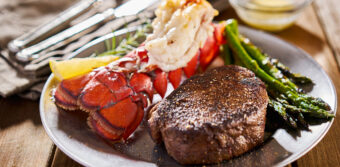Johnny Pope asks: Why do people on death row get whatever meal they want right before they die?
 If you happen to ever find yourself slated to have society as a whole decide it would be best if they killed you, the silver lining is that in many parts of the world where this is still a thing, the last meal you ever eat is likely to be significantly better than the ones you’ve been consuming up to that point in prison. So how did this rather odd meal tradition come about and is it actually true death row inmates can get anything they want to eat?
If you happen to ever find yourself slated to have society as a whole decide it would be best if they killed you, the silver lining is that in many parts of the world where this is still a thing, the last meal you ever eat is likely to be significantly better than the ones you’ve been consuming up to that point in prison. So how did this rather odd meal tradition come about and is it actually true death row inmates can get anything they want to eat?
To begin with, while it’s commonly stated that the whole idea of the last meal request came about due to Christ’s famed last supper, there doesn’t seem to be any direct evidence of this.
So how did the tradition actually start?
While history is absolutely littered with various cultures having feasts associated with death, such as the public feast for Roman gladiators the night before their potential date with death, called the coena libera, it wouldn’t be until slightly more modern times where we start seeing those being executed widely granted such a courtesy en masse. Once this did start to become a thing, in the early going, while wealthy individuals slated for execution, as ever, could generally request whatever they wanted any time, and were even often allowed servants to attend them as they awaited their execution, common things granted to the poor before their execution seem to have been at best a swig of some alcohol or the like.
Things began to pick up steam considerably on this front around the 16th century, however. Or, at least, things appear to have. It is entirely possible that such courtesies were widely granted before this to even the poor, with documented evidence of it simply not surviving. On that note, things like the printing press’ invention in the 15th century began making documented history of rather mundane events like the executions of random Joe Citizens more, well, documented. Thus, it may or may not be coincidence that accounts of such courtesies started to pop up more and more around the 16th century and progressing from there.
Whatever the case, by the 18th century, particularly in places like England, such practices were definitely around and relatively common. For example, in London it was common to allow the condemned to enjoy a meal with various guests, generally including the executioner, on the eve of the execution. Further, there is record of Newgate Prison death row inmates being allowed to stop at a pub on their march to their death at the Tyburn Fair gallows. At the pub, they would typically share drinks with their guards and executioner.
Over in Germany, perhaps the best documented case of the food practice around this time was that of Susanna Margarethe Brandt of Frankfurt. On January 14, 1772, Brandt, a poor servant girl, was executed for allegedly killing her newborn child. Eight months before this murder, she’d become pregnant by a journeyman goldsmith who she never saw again after they had sex. She subsequently successfully hid her pregnancy all the way to the eighth month when she gave birth secretly and alone in a laundry room on August 1, 1771. Unfortunately, when the baby came out, whether because newborn babies are insanely slippery or she just failed to realize it was about to drop, it fell from her and smacked its head against the stone floor. The child then, according to her, wheezed momentarily and then ceased to breathe. Brandt subsequently panicked, hid the baby in a stable and fled the scene. However, having no money or means to support herself, the next day she returned to Frankfurt where she was eventually arrested for murdering the child. Whether she did or not, and even if it would have survived anyway given it was premature, is a matter of debate even today, but she was nonetheless convicted of the murder and sentenced to death.
Shortly before her execution, however, she was the guest of honor at what has been dubbed the “Hangman’s Meal”- a rather large feast prepared for the condemned and various officials who had condemned her. If you’re curious, the meal in this case supposedly was “three pounds of fried sausages, ten pounds of beef, six pounds of baked carp, twelve pounds of larded roast veal, soup, cabbage, bread, a sweet, and eight and a half measures of 1748 wine.” Of course, the young Susanna reportedly ate none of it, merely drinking a little water as the officials feasted around her. Not long after, her head was lopped off.
Moving over to the United States where the idea of the “last meal” is perhaps best known today, it would appear this tradition did not initially jump across the pond when Europeans began setting in the Americas. Or, at least, surviving accounts of executions don’t seem to mention such courtesies, with some exceptions usually having to do with drink or something to smoke. For example, in 1835, the New York Sun reported shortly before his execution, murderer Manuel Fernandez requested and was granted a bit of brandy and some cigars, courtesy of the warden at Bellevue prison.
As the 19th century progressed, this sort of thing became more and more reported, as did eventually the practice of granting last meal requests, which by the early 20th century became quite common.
This all leads us to why. Well, as far as more historic cases, such as the early known instances in Europe, it’s generally hypothesized that people did it as a way for officials and executioners to more or less say to the prisoners “We’re going to kill you, but it’s nothing personal.” In essence, offering a bit of kindness to the condemned before their death with the prisoners themselves seemingly appreciating the courtesy, at least when it came to the alcohol.
On that note, it’s widely reported from this that the practice was instituted as a way to ensure the ghosts of the executed would feel friendly towards their condemners and executioners and thus not come back and haunt them, but we couldn’t find any primary documentation backing such a notion.
Whether that’s true or not, moving on to more modern times, the underlying reason why prison officials started doing this is not any better documented and there doesn’t ever seem to have been any laws requiring it, for instance. It’s just something people did on their own and the idea spread, presumably thanks to the media’s then love of reporting everything about the last hours of those being executed, and the general public eating it up across the nation.
Whatever the case, law professor Sarah Gerwig-Moore, co-author of Cold (Comfort?) Food: The Significance of Last Meal Rituals in the United States, posits of all this,
Last meals may be an offering by the guards and prison administrators as a way of seeking forgiveness for the impending execution, signaling that ‘it’s nothing personal.’… There are standard operating procedures that put up a wall between guards and prisoners, but nevertheless, there is a fondness between them… The last meal as a tradition is really a way of showing humanity between the caregivers of people on death row who are completely powerless and who come to care about these people — they feel complicit, and conflicted. The last meal is a way to offer, in a very, very small way, a show of kindness and generosity.
On this point, she also notes from her research, “The most generous meals correlate to the states that execute the most people — except for Texas…”
Texas, of course, having executed about 1,300 people in the last two centuries and trending the opposite of everyone else- actually increasing the number of executions in recent decades. For reference here, they’ve conducted 562 executions (almost half their couple century total) since 1982- apparently doing their best to adhere to the supposed 13th century Papal decree at the Massacre at Béziers, “Caedite eos. Novit enim Dominus qui sunt eius.” This translates to, “Kill them. For the Lord knows those that are His own.” Or to put it in the form that is apparently Texas’ state motto- “Kill ’em all and let God sort ’em out.” (Joking asside, Texas’ state motto is actually the single word- “friendship”, owing to the fact that the name of the state derives from the Caddo word for “friends” or “allies”.)
On the note of Texas, last meals, and being friendly, in 2011 Senator John Whitmire very publicly pushed for an ultimately got the special meal requests for those about to be executed abolished, at least officially. He noted of this, “It is extremely inappropriate to give a person sentenced to death such a privilege… enough is enough… If you’re fixing to execute someone under the laws of the state because of the hideous crime that someone has committed, I’m not looking to comfort him… He didn’t give his victim any comfort or a choice of last meal.”
That said, proponents on the other side of that argument generally state that part of the point of offering such courtesies is to demonstrate that while the state is killing someone on behalf and with the express consent of the public as a whole, if it’s not done in a humane way, the public and the state are no better than the person being killed. As Professor Kathy Zambrana of the University of Florida sums up, “It comes down to how do you treat one human being when you’re about to take someone’s life.”
History professor Daniel LaChance of Emory University further chimes in, “These last meals — and last words — show the state is democratic and respects individuality even as it’s holding people accountable. As horrible as the deed they’ve been convicted of [is], the person still has some kind of dignity that we’re acknowledging.”
As to what drew the ire of Senator Whitmire to come against the then almost century old Texas tradition of the last meal, it was the meal request of death row inmate Lawrence Russel Brewer, who was sentenced to death for taking part in the rather horrific and senseless racially motivated murder of James Byrd Jr in 1998. So what did Brewer ask for? A couple chicken fried steaks, a triple decker bacon cheeseburger, a beef and cheese omelet, fried okra, a full pound of BBQ, a half loaf of bread, three fajitas, and a meat lover’s pizza. For dessert, he requested a container of Blue Bell ice cream and peanut-butter fudge. To wash it all down, he asked for three root beers.
When the time came, however, he ultimately ate nothing.
This all brings us to whether inmates can actually request and receive basically anything they want. While the media widely reports this is the case, including with this specific example of Brewer, this isn’t correct at all. In fact, in the vast majority of cases where inmates request something elaborate like this, what they actually get is just a simple, one-person version of it.
As famed “death row chef” Brian Price, who prepared well over 100 such meals, states, “The local newspaper would always say they got 24 tacos and 12 enchiladas, but they would actually get four tacos and two enchiladas… They only get items in the commissary kitchen. If they order lobster, they get a piece of frozen pollack. They quit serving steaks in 1994. If they order 100 tacos, they get two or three.”
That said other states and prisons sometimes do it differently. For example, in nearby Oklahoma, they allow the meal to be purchased from a local restaurant if desired, though capping it at $15… Other states that allow similar, such as Florida, are more generous, allowing for a budget of $40.
Of course, as you might have guessed from all we’ve said so far, those actually involved in making or acquiring the last meal may or may not pitch in if they so choose to go beyond. For example, in Cottonport, Louisiana, when one unnamed death row inmate requested lobster, the warden at the Angola prison, Burl Cain, went ahead and paid for a full lobster dinner, with Cain then dining with the inmate. You see, much like many historical instances of this sort of thing, before Cain’s recent retirement, he would always extend an invitation to the condemned to have their last meal with him and sometimes other select guests.
Of course, as with Susanna Brandt and Lawrence Brewer, it’s quite common for death row inmates to forgo eating their “last meal”, as the whole impending death thing generally leaves many without an appetite. To try to get around the problem, the so-called last meal is sometimes not actually the last meal at all, with it generally designated the “special meal” by prison officials. Even when it is literally the person’s last meal, it is usually scheduled far enough ahead that they might still be able to eat, but not so far away that they’ll have to go an extended time without eating before their execution. For example, in Virginia the rule is the meal must be served at least four hours before the execution. In Indiana, they go even further with the special meal often coming a few days before the big show, in a time when the person can actually enjoy it on some level.
For those who don’t have an appetite, they often share. For example, in places like Florida, in certain cases family or friends may be allowed to enjoy the meal with the condemned. Some inmates instead donate it to others. For example, in 1951, Raymond Fernandez, one of the “Lonely Hearts Killers” along with his lady love Martha Jule Beck, made a request that his meal be given to another inmate to enjoy.
On a similar note, in the early decades of this tradition in Texas, it was relatively common for the condemned to order and be given large portions of food for their special meal precisely so they could have enough to share with every other inmate on death row in the prison. This extra food request was usually honored by prison officials because it was seen not just as a mercy, but something that helped keep all those on death row in line directly before executions.
That said, not all inmates have trouble eating. Perhaps the most famous case of this was murderer Rickey Ray Rector. After committing two rather senseless murders, he attempted to kill himself by shooting himself in the head. However, he ended up living through the ordeal owing to shooting himself in the temple- a common way to kill one’s self in the movies, but in reality very survivable if medical aid is nearby, with the person effectively having just given themselves a lobotomy.
Despite his rather deficient mental faculties as a result of the whole bullet through the brain thing, Rector was controversially sentenced to death. The issue became even more of a media sensation after the fact when it was learned that while he happily ate his last meal, he chose not to eat the pecan pie that he got with it. Why? He told the guards he was “saving it for later.”
Once again showing the humanity of the guards involved, they went ahead and saved the piece of pie just in case there was a last minute stay of execution.
This all brings us to what prisoners actually usually request for their last meal. While exact fare is rather diverse (for example in one case a person simply requested a “jar of pickles” according to the aforementioned Brian Price), if categorizing this into groups, it often comes down to either things you’d find at McDonald’s or KFC (or literally McDonald’s or KFC meals in many cases), something fancy, or a favorite home cooked meal from the person’s childhood or the like.
As for the first two categories there, it’s noted that the vast majority of death row inmates come from rather impoverished backgrounds, and thus often go with favorite food items they are accustomed to and haven’t gotten while in prison- things like fried chicken, cheeseburgers, french fries, and soda, or the like. That said, some go the other way, picking foods they couldn’t really afford when in the land of the free, or may have never even tried at all, like lobster or filet mignon. As for favorite home cooked meals, the aforementioned Brian Price states when he prepared these meals, he always did his best to make it just as the inmate described, or even potentially getting a specific recipe from the condemned’s loved ones.
Regardless of what camp one goes with, some choose their last meal not on what they necessarily intend to eat, but rather to make a statement.
As for such statements, going back in time a bit in 1963, murderer Victor Feguer requested nothing more than a single solitary unpitted olive for his last meal. He then requested the seed be buried with him in the hopes that it would grow an olive tree as a symbol of peace and rebirth.
On a similar note, one Jonathan Wayne Nobles, who apparently had been on drugs since he was 8 years old living in foster homes, as an adult murdered two women while high on a cocktail of substances. In prison, however, he got off the drugs and became a devout Catholic and, not just model inmate, but model person. As one example, at one point he attempted to save the life of a random woman he heard about who was dying from kidney failure. However, while he did successfully find a doctor willing to perform the procedure to take one of his kidneys out and give it to the woman, it ultimately turned out the pair were did not have matching blood types and the woman died. Doubling down, Nobles later attempted to have all his organs donated after his execution, but this request was denied as Texas did not allow death row inmates to donate their organs. Going back to his last meal request, he simply asked for the Eucharist (communion).
To end on a lighter note- well… relatively speaking…- in the 1940s Wilson De la Roi, who murdered a man while in prison, was slated to be killed via a somewhat newly minted poison gas chamber in San Quentin. When asked what he wanted for his last meal, he merely requested a bunch of indigestion tablets. When asked why, he stated that he felt sure he was soon to have rather severe case of gas…
If you liked this article, you might also enjoy our new popular podcast, The BrainFood Show (iTunes, Spotify, Google Play Music, Feed), as well as:
Expand for References






 If you’ve ever seen pretty much any action movie involving a badass spy or member of law enforcement, you know a common trope in the industry is to have the protagonist firing away at the bad guys with a gun in both hands. But is this ever actually done in real life and, if so, what’s considered the proper method for such badass looking weapon wielding?
If you’ve ever seen pretty much any action movie involving a badass spy or member of law enforcement, you know a common trope in the industry is to have the protagonist firing away at the bad guys with a gun in both hands. But is this ever actually done in real life and, if so, what’s considered the proper method for such badass looking weapon wielding?






 In this episode of The Brain Food Show, we start by looking at the first woman in the United States to cast a political vote who for reasons we’ll get into did it with her feet…
In this episode of The Brain Food Show, we start by looking at the first woman in the United States to cast a political vote who for reasons we’ll get into did it with her feet…




















 If you happen to ever find yourself slated to have society as a whole decide it would be best if they killed you, the silver lining is that in many parts of the world where this is still a thing, the last meal you ever eat is likely to be significantly better than the ones you’ve been consuming up to that point in prison. So how did this rather odd meal tradition come about and is it actually true death row inmates can get anything they want to eat?
If you happen to ever find yourself slated to have society as a whole decide it would be best if they killed you, the silver lining is that in many parts of the world where this is still a thing, the last meal you ever eat is likely to be significantly better than the ones you’ve been consuming up to that point in prison. So how did this rather odd meal tradition come about and is it actually true death row inmates can get anything they want to eat?




